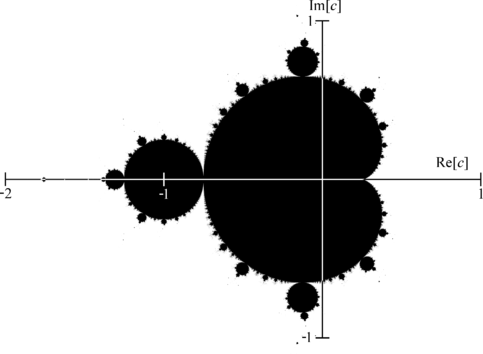Does the complex number belong to the Mandelbrot set?
The Mandelbrot set is the set of complex numbers for which the function does not diverge when iterated from i.e., for which the sequence remains bounded in absolute value. Whether a number in the complex plane lies in the Mandelbrot set or not depends on these two possibilities:
- When starting with and applying the iteration repeatedly, the absolute value of remains bounded however large gets. It's a property of the function that the upper bound never gets larger than .
- When starting with and applying the iteration repeatedly, the absolute value of is unbounded such that for certain iterations the modulus of the value of the function exceeds 2. It so happens that the higher the number of iterations for such a complex number, the higher would be the modulus of the result.
This is best explained by an example. Let us find out whether belongs to the Mandelbrot set We have: For the first iteration, we have and Thus For the next iteration, we put and Thus Next, we have Since the modulus of is which is greater than , the number does not belong to the Mandelbrot Set.
In contrast, when we take the complex number : For the first iteration, we have, modulus of (-1) is 1 Next we have, modulus of (0) is 0 For the next iteration we have, modulus of (-1) is 1 Hence, we keep on alternating between and and the values of never exceed 2.
Similarly, we can prove that lies in the Mandelbrot set.
Can you tell whether lies in the Mandelbrot set or not?
The given image is a mathematician's depiction of the Mandelbrot set M. A point
is colored black if it belongs to the set, and white if not. Re[c] and Im[c] denote the real and imaginary parts of
, respectively.

This section requires Javascript.
You are seeing this because something didn't load right. We suggest you, (a) try
refreshing the page, (b) enabling javascript if it is disabled on your browser and,
finally, (c)
loading the
non-javascript version of this page
. We're sorry about the hassle.
i does indeed belong to the Mandelbrot set.
We have: f c ( z ) = z 2 + c
Thus, for the first iteration, f i ( 0 ) = 0 2 + i = i , ∣ i ∣ = 1
Next, f i ( i ) = i 2 + i = i − 1 , ∣ i − 1 ∣ = 2
Next, f i ( i − 1 ) = ( i − 1 ) 2 + i = − i , ∣ − i ∣ = 1
Thus, the values keep alternating between 1 and 2
Here is a brilliant video by Numberphile explaining this concept: https://www.youtube.com/watch?v=NGMRB4O922I
Copy and paste this link in the URL bar to view the video.